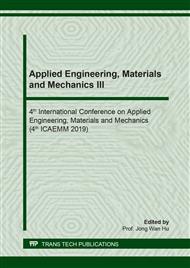p.82
p.87
p.92
p.99
p.104
p.113
p.118
p.123
p.128
Vibration Analysis of Fiber Reinforced Composite Laminated Plates with Arbitrary Boundary Conditions
Abstract:
A Fourier series method based on Mindlin theory and Hamilton variation principle has been proposed for the vibration modeling and analysis of composite laminated plates with arbitrary boundary conditions, in which the vibration displacements are sought as the linear combination of a double Fourier cosine series and auxiliary series functions. Three types of constrained springs are introduced to establish a general structural model of composite laminates, and the vibration model is established by combining the Hamilton energy principle. The accuracy, efciency and validity of the two solutions presented are demonstrated via comparison with published results. The influence of boundary conditions, laying angle and laying layer on vibration characteristics is analyzed. And it can be seen that the frequency of the structure increases with the increasing of the spring stiffness and the number of laying layers of the boundary of the laminated plate structure.
Info:
Periodical:
Pages:
104-112
Citation:
Online since:
August 2019
Authors:
Price:
Сopyright:
© 2019 Trans Tech Publications Ltd. All Rights Reserved
Share:
Citation:


